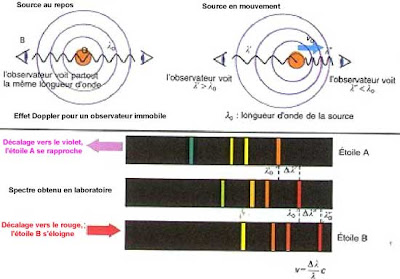Although men have always had your head in the stars is in the 20's that scientists were interested in distant galaxies. Wanting to know whether other galaxies were similar to ours in chemical composition, they observed what they call their absorption spectra *.

Quick summary of what a ghost. It has many possible wavelengths in the light that actually very few are visible to the eye nu. Among the smaller wavelengths include, for example X-rays used in x-ray, ultraviolet, too. And in the very long wavelength infrared is found (which is aptly named) and radio waves.
Scientists discovered two different things. The first is that the composition of other galaxies was broadly similar to ours. Well, but what was really interesting and unexpected is that the absorption lines observed were all redshifted!
Here is what an absorption spectrum. We clearly see the lines black in the spectra. They correspond to the chemical elements that have absorbed the wave, so we can see on the spectrum. We can clearly see that the absorption lines are all redshifted, even if same chemicals. Strange!
Why this discrepancy and what can it mean? To understand this phenomenon, we must already understand the Doppler effect. It's pretty simple, you probably already know the famous example of the ambulance siren: when this one gets closer, the sound becomes increasingly acute. Why? Because the wavelengths are reduced and thus form a higher pitch. Conversely, when the ambulance recedes, the sound becomes more serious. In this case, the wavelength range.For electromagnetic waves (like light) is the same. When an item moves, it tends towards the red (long wavelength) and when it gets closer, he tends toward the blue (short wavelength).

This scheme not be beautiful and a bit complicated, however, explains very well the phenomenon. Both regimens waveform up very well describe the Doppler effect and the variation of wavelengths depending on the movement of the object observed. Below, we have here the spectra, which describe what has been seen scientists!
 nod to fans of The Big Bang Theory where Sheldon is disguised as the Doppler Effect for Halloween. A great moment.
nod to fans of The Big Bang Theory where Sheldon is disguised as the Doppler Effect for Halloween. A great moment. consequence of that, if all galaxies are slightly red, because it is full speed away from us! Best, the scientific Hubble discovered in 1929 that the rate of removal was proportional to the distance of the galaxy. Basically, the more they are far from us, the more they move away quickly!
This discovery was one of the largest in the world of physics, and was the basis of extensive research done today on this phenomenon.
However, the explanation by the Doppler effect is not entirely fair. Indeed, it was realized later that to respect the laws of general relativity, this is not the galaxies are moving in space, but it is space itself that is expanding. Therefore, the shift in the red that we observe is not due to displacement of the emission source, but the fact that space itself expands, which also extends the wavelength light ! As the wavelength is increased, one sees a redshift.

diagram representing the expansion of the universe after what is called a singularity (here it would be the Big Bang). We note that the galaxies have always represented the same size, it is space that is expanding and the galaxies not moving.
To give an idea of what the universe is expanding, we must imagine a cake with grapes. Initially small grapes are close to each other in the dough. Then as it inflates, the distance between the grapes increases without those they do not change size, speed and distance is even larger than the grains are far! Bah the universe is a giant raisin cake!
~~~~~~~~~~~~~~~~~~~~~~~~~~~~~~~~~~~~~~~~~~~~~~~~ ~~~~~~~~~~~~~~~~~~~~~~~~~~~
* What is an absorption spectrum you ask me. Well, when light passes through an element, some chemical components of this element can absorb certain wavelengths of light. The result of this is that when one observes the spectrum of this light, we'll see a black stripe, corresponding to the chemical in question.
And when one observes the spectrum of a galaxy is the same. We study the spectrum of light that reaches us, and depending on the streak that we see, we know what are the chemical components of this galaxy.
~~~~~~~~~~~~~~~~~~~~~~~~~~~~~~~~~~~~~~~~~~~~~~~ ~~~~~~~~~~~~~~~~~~~~~~~~~~~~
Sources:
Stephen Hawking: A Brief History of Time. Pages 60-62. Edition Flammarion.
http://en.wikipedia.org/wiki/Redshift
http://fr.wikipedia.org/wiki/Expansion_de_l% 27Univers
0 comments:
Post a Comment